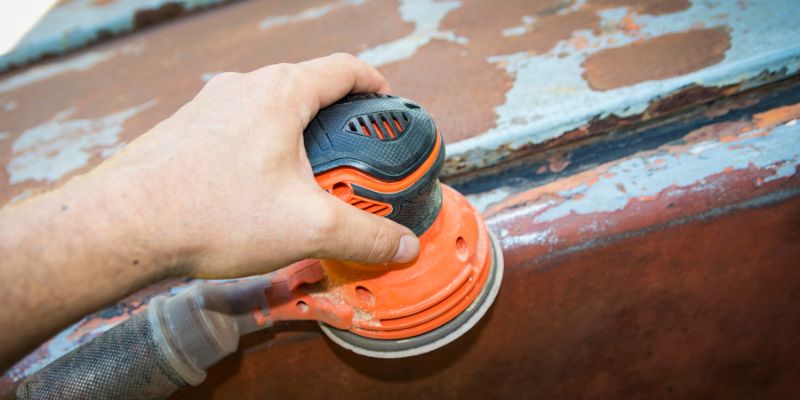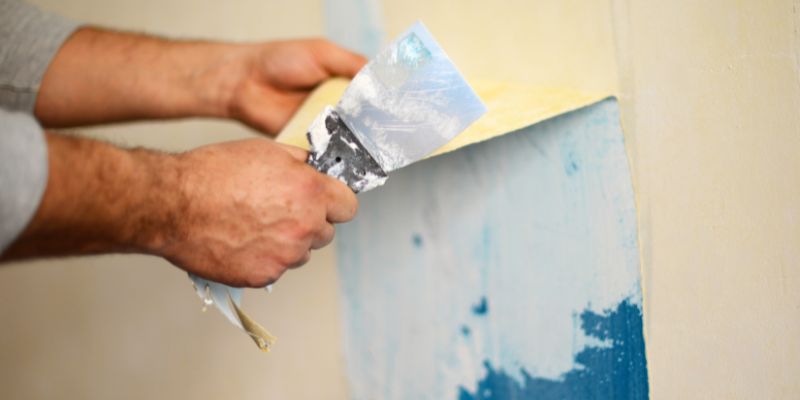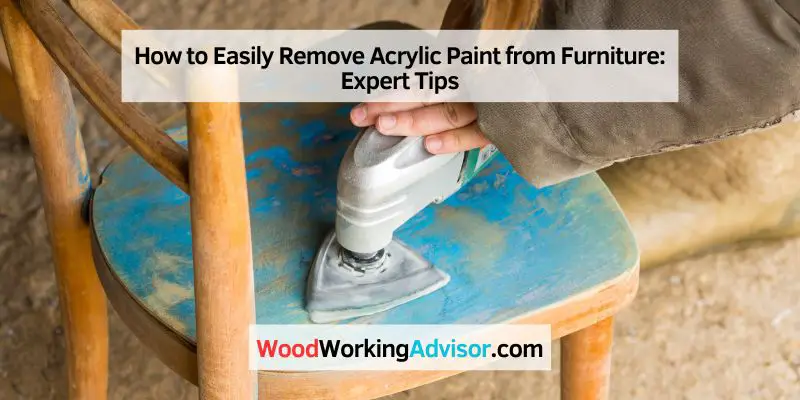To remove acrylic paint from furniture, apply rubbing alcohol on a cloth and gently rub the affected area. Acrylic paint can add a beautiful touch to furniture, but accidents happen, and you may find yourself needing to remove it.
Whether you spilled paint during a DIY project or your child got a little too creative, it’s important to clean it up properly to avoid any long-term damage. In this guide, we’ll provide you with an easy method to remove acrylic paint from furniture.
By following these steps, you’ll be able to restore your furniture’s original appearance without the need for expensive professional assistance. Let’s dive in and learn how to effectively remove acrylic paint from furniture.
Preparation And Tools
Learn how to effectively remove acrylic paint from furniture using the right preparation and tools. Discover the step-by-step process to restore your furniture to its original condition with ease.
Gather Necessary Materials
To successfully remove acrylic paint from furniture, you will need to gather a few essential tools and materials. By having these items ready, you can efficiently tackle the task at hand. Consider the following:
- Bristle brush to remove loose paint particles
- Plastic scraper for gentle scraping
- Soft cloth or sponge for cleaning
- Mild soap or detergent to create a cleaning solution
- Warm water to mix with the soap or detergent
- Isopropyl alcohol to help dissolve the dried paint
- Cotton swabs for small and stubborn paint areas
- Protective gloves to keep your hands safe
Having these materials on hand will ensure you have everything you need to effectively remove acrylic paint from your furniture.
Protect The Surrounding Area
Before you begin the paint removal process, it’s crucial to protect the surrounding area. This step will prevent any accidental damage or further mess. Here’s what you need to do:
- Cover the floor with newspaper or plastic sheets to catch any paint that may accidentally drop.
- Use painter’s tape to secure the edges of the protective covering, ensuring that it stays in place.
- Consider removing the furniture from the room if possible. This will provide a more controlled environment and prevent any unintentional splatters on nearby surfaces.
- If removing the furniture is not an option, ensure the area around the furniture is clear of any valuable items or objects that could be damaged by paint.
Taking these precautions will safeguard your surroundings and minimize the potential for any unnecessary damage.

Applying The Removal Method
To remove acrylic paint from furniture, start by using a scraper to gently lift off the paint. Then, apply a commercial paint remover and let it sit for 15-20 minutes. Finally, use a clean cloth to wipe off the paint and repeat the process as needed until the paint is fully removed.
Removing acrylic paint from your furniture may seem like a daunting task, but with the right technique, you can restore your furniture to its original beauty. In this section, we will explore two effective methods for removing acrylic paint from furniture: testing in a small area and using solvents or cleaners. It’s important to approach each method carefully to avoid any damage to your furniture’s surface.
Testing In A Small Area
Before diving into the full removal process, it is crucial to test your chosen method in a small, inconspicuous area of the furniture. This allows you to ensure that the method doesn’t cause any unwanted discoloration or damage. Here’s how you can perform a simple and effective test:
- Clean the small area with mild soap and water to remove any dirt or grime.
- Apply a small amount of the chosen removal method to the tested area.
- Gently rub the area with a cloth or sponge and observe the reaction.
- Wait for at least 24 hours to see if there are any adverse effects.
If the test area shows no signs of damage or discoloration, you can proceed with confidence to the rest of the furniture.
Using Solvents Or Cleaners
If the test area proves successful, you can now move on to applying solvents or cleaning agents to remove the acrylic paint from your furniture. Here are some popular options:
| Solvent/Cleaner | Description |
|---|---|
| Isopropyl Alcohol | A commonly used solvent that can break down acrylic paint without damaging most surfaces. |
| Denatured Alcohol | An effective option for tougher acrylic paint stains, but it should be used with caution on sensitive surfaces. |
| Nail Polish Remover | Containing acetone, this option is best suited for small paint spills or stains on plastic or metal surfaces. |
When using solvents or cleaners, follow these steps:
- Ensure the area to be treated is well-ventilated.
- Dampen a cloth or sponge with the chosen solvent or cleaner. Do not soak it.
- Gently dab or rub the affected area, starting from the edges and working towards the center.
- Continue until the paint begins to dissolve or lift from the surface.
- Once the paint loosens, use a clean cloth or sponge to wipe away the residue.
- Rinse the area with water and dry it thoroughly.
Remember to always check the manufacturer’s instructions and test any solvent or cleaner on a small area before applying it to the entire surface. With careful application and the right technique, you’ll be able to remove acrylic paint from your furniture, restoring its original appearance.
Mechanical Removal Techniques
When it comes to removing acrylic paint from furniture, mechanical removal techniques can be highly effective. These methods involve using physical force to scrape, sand, or apply heat to the painted surface, loosening the paint for easy removal. Below, we’ll explore two prominent mechanical removal techniques for getting rid of acrylic paint from furniture.
Scraping And Sanding
Scraping and sanding are versatile methods for removing acrylic paint from furniture. Scraping involves using a putty knife or paint scraper to gently lift and remove layers of paint from the surface. Sanding, on the other hand, employs abrasive materials such as sandpaper to gradually wear away the painted layers.
- Use a putty knife or paint scraper to gently lift and remove layers of paint from the surface.
- Employ abrasive materials such as sandpaper to gradually wear away the painted layers.
Utilizing Heat Guns
Utilizing heat guns can be an efficient way to remove acrylic paint from furniture. By applying heat to the painted area, the paint becomes softer and more pliable, making it easier to scrape off. However, caution should be exercised to prevent damage to the underlying surface due to excessive heat exposure.
Final Steps
Now that you have successfully cleaned and removed acrylic paint from your furniture, it’s time to complete the process. The final steps involve cleaning and restoring the surface of the furniture as well as adding some finishing touches to make it look as good as new.
Cleaning And Restoring The Surface
After removing the paint, make sure to thoroughly clean the surface of the furniture. Use a mild detergent mixed with water to wipe away any remaining residue or cleaning solution. Rinse the surface with clean water and dry it thoroughly using a soft cloth. This will ensure that no cleaning product remains on the furniture and prevent any damage to the surface.
Finishing Touches
Once the surface is clean and dry, it’s time to add some finishing touches. Depending on the type of furniture and its finish, you may need to apply a fresh layer of paint, varnish, or polish to restore its original look. If there are any scratches or dents, you can use a wood filler to repair them. Sand the surface lightly to smoothen any rough areas and apply the appropriate finish. This will not only make the furniture look great but also protect it from further damage.
To enhance the appearance of the furniture further, you can also consider applying a wax or furniture polish. This will give it a beautiful shine and help to protect the surface from future stains and spills. Remember to follow the instructions on the product packaging and apply the wax or polish using a soft cloth in even strokes. Allow it to dry completely before using or placing any items on the furniture.
And there you have it! Your furniture has been successfully restored and is now free from acrylic paint. By following these final steps, you have not only managed to remove the paint but also ensured that your furniture looks as good as new and is well-protected for years to come.

Frequently Asked Questions On How To Remove Acrylic Paint From Furniture
What Removes Dried Acrylic Paint?
Acetone or isopropyl alcohol can remove dried acrylic paint effectively.
How Do You Remove Dried Acrylic Paint From Wood Furniture?
To remove dried acrylic paint from wood furniture, use a soft cloth soaked in warm soapy water. Gently scrub the paint until it loosens. If needed, use a plastic scraper or fine-grit sandpaper to remove stubborn paint. Finish by wiping the area with a damp cloth and allowing it to dry.
Does Acrylic Paint Wash Off Furniture?
Yes, acrylic paint can be washed off furniture with water and soap. It’s important to remove it promptly.
How Do You Get Dried Acrylic Paint Out Of A Couch?
To remove dried acrylic paint from a couch, mix equal parts dish soap and warm water. Apply the solution to the stain, lightly scrubbing with a sponge. Blot with a clean cloth, repeating the process until the paint is removed.
Finish by wiping the area with a damp cloth and allowing it to air dry.
Conclusion
Removing acrylic paint from furniture can be done with simple household items and a bit of elbow grease. By using the right techniques and being patient, you can restore your furniture to its original state. Taking care during the process will ensure that the furniture remains undamaged, providing a satisfying result.


